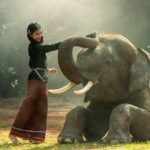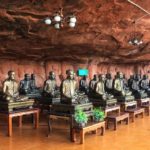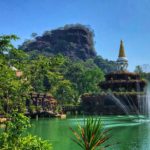Thailand’s Buddhist Vision of Hell in Literature & Temples
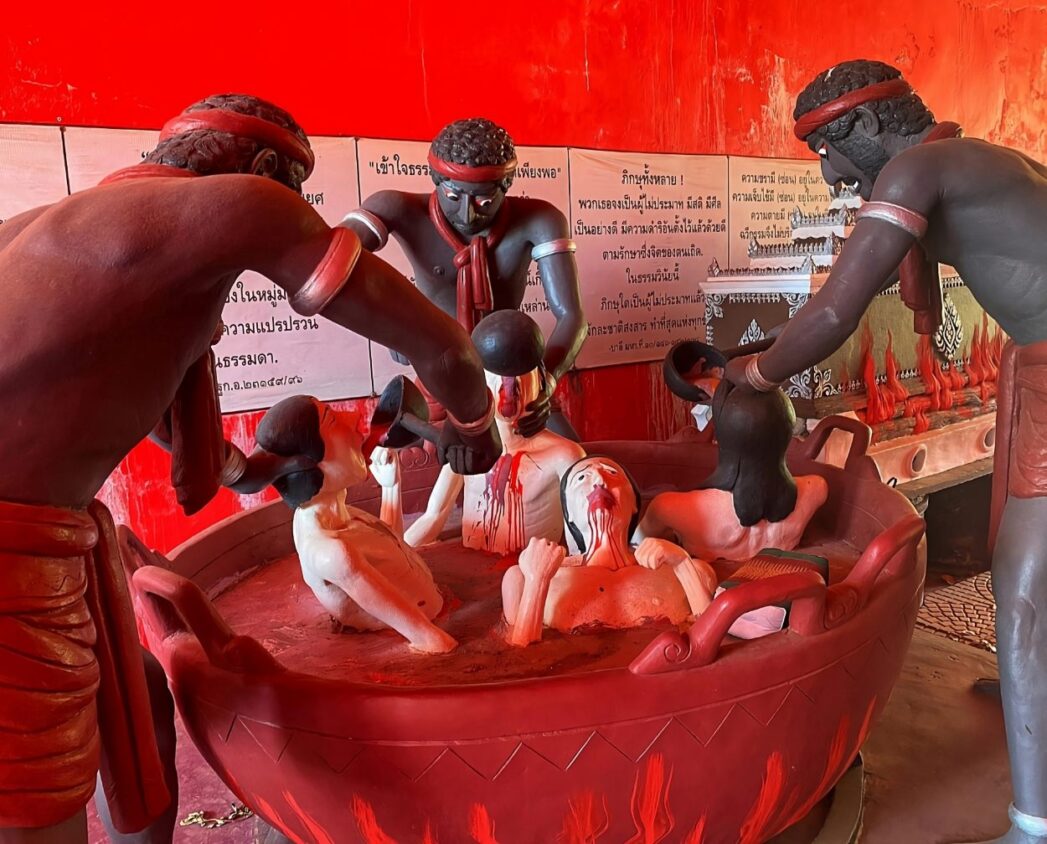
Depictions of Hell at Thai temples will often feature sinners in a boiling cauldron of blood or water, as seen here at Wat Khao Tham Phra in Sakon Nakhon (Northeast Thailand).
Terrifying representations of hell have been used by most societies to encourage good behavior and tamp down on evil. Thailand is no different in its depictions of hell, which trace their origin to traditional Thai folklore, as well as the Traiphum Phraruang (ไตรภูมิพระร่วง) or Traiphum Katha (ไตรภูมิกถา) — a treatise on Buddhist cosmology.
Written during the 19th century of the Sukhothai period by King Phra Maha Thammaraja I (พระมหาธรรมราชาที่ I), who based his treatise on ancient Buddhist texts, the Traiphum Phraruang involves 3 worlds, where we can see the influence of Hinduism on Thailand’s Buddhist cosmology:
1. Kam Phum (กามภูมิ), the realm related to sensual desires (e.g. love, greed, anger, etc.) and delusion. It is divided into two areas: heaven and hell.
2. Roop Phum (รูปภูมิ), the form filled land of Brahma (who in Hinduism is known as the creator god, who is part of the Supreme Trinity, along with Shiva and Vishnu)
3. Arup Phum (อรูปภูมิ), the land of formless Brahma
Thai language Note: Students of the Thai language might expect the Thai word “phum” (ภูมิ) to be pronounced “phumi” or “bhumi,” especially as it is pronounced this way in the name of King Bhumibol Adulyadej (ภูมิพลอดุลยเดช) the Great. However, the Thai word (ภูมิ), which means grounds or site, is pronounced as “phum”. And when it is combined with other Thai words to form a new word or name, it can be pronounced either “phum” or “phumi” (also spelled as “bhumi”), depending on the new word/name that is being formed.
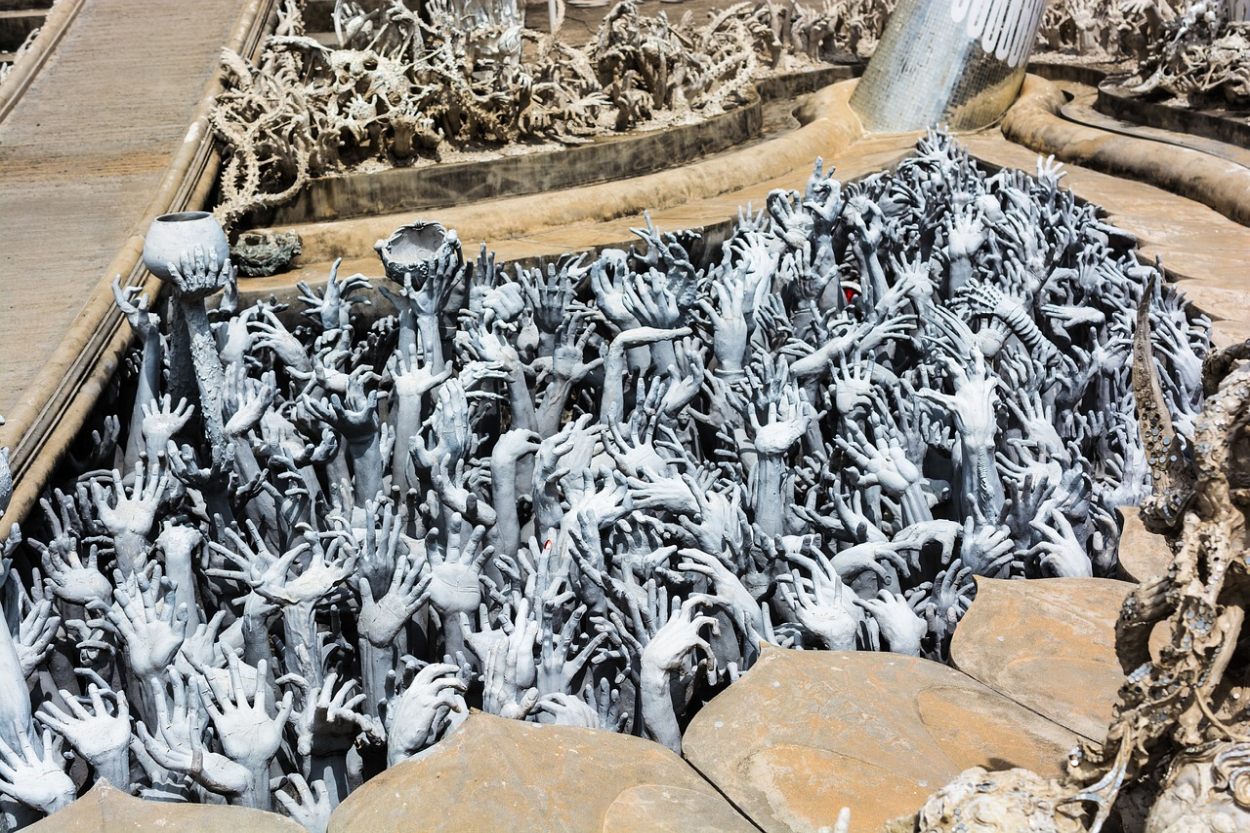
The 8 Pools of Thai Hell
According to the Traiphum Katha, hell in “Kam Phum” is filled with the dead who have committed sins through body, speech, and mind. They descend into the netherworld and are reborn as hell creatures to live out their karma under the human world.
This Thai vision of hell is called “narok” (นรก), which is derived from the Buddhist term for hell “naraka” (in the Pali language). In hell there are 8 large pools where the dead are placed, depending on the sins they committed:
Sancheep Narok (สัญชีพนรก) — This pool of hell is reserved for those who have exploited others. Spending one day in this hell is equal to 9 million human years. The banished are tortured by sharp weapons until death. Then the “wind of karma” will resurrect them for another round of punishment.
Kalasutta Narok (กาฬสุตตนรก) — This hell is filled with people who have harmed those who have shown them kindness or have killed animals unnecessarily. They will be lashed by a black rope for 1,000 hell years, with one 1 hell day equaling 36 million human years.
Sangkhat Narok (สังฆาฏนรก) — This is a crushing hell for those without mercy who like to abuse others. They will be hit with an iron hammer and crushed by fireballs and mountains of iron for 2,000 hell years, with 1 hell day equal to 145 million human years.
Roruwa Narok (โรรุวนรก) — This is a groaning hell reserved for greedy and dishonest people. They are punished by lying face down with their head, hands, and feet buried in an iron lotus that’s engulfed in fire. The tortured will wail in suffering for 4,000 years. One day of this Thai hell is equal to 234 million human years.
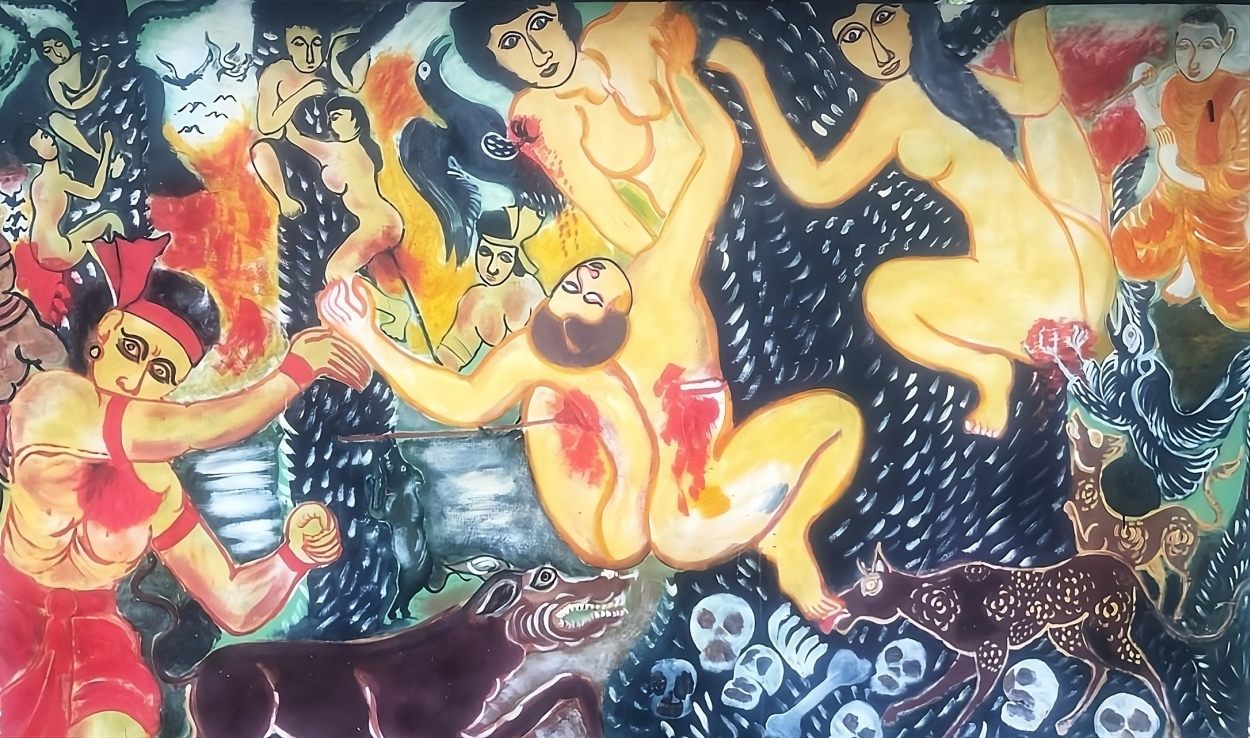
Maha Roruwa Narok (มหาโรรุวนรก) — This pool of hell is filled with even greater groaning. It is filled with cruel-hearted people who do evil and are filled with vengeful thoughts. The iron lotus of this hell has sharper petals and the entire person is immersed in this blazing iron lotus cauldron for 8,000 years, with 1 hell day equaling 9 Billion and 216 million years.
Dtaap Narok (ตาปนรก) — This piercing hell is for sinners who are full of passion. They will be impaled by a steel spear, and then hell dogs will tear at their flesh and eat them for 16,000 years, with 1 day of hell equaling 18 Billion and 432 million human years.
Maha Dtaap Narok (มหาตาปนรก) — This is a fiery hell for those who have killed someone or killed animals in large numbers unnecessarily. They must stay within blazing walls and iron mountains full of thorns, where whirlwinds continually impale them against the thorns. They must suffer here for half a “gan” (กัลป์), also known as a “kalpa,” which is a length of time in years equal to the number 1 followed by 70 zeros.
Awejee Narok (อเวจีนรก) — This is the harshest and most merciless hell in Thailand’s Buddhist cosmology. It is the deepest and widest hell, reserved or those who have committed the heaviest karma, including killing parents and revered Thai monks. The person is surrounded by an iron wall engulfed in flames, and consumed by fire in various postures according to their karma, while an iron rod is inserted through their body, immobilizing them in their torture. The lifespan of this suffering is 1 “gan” or “kalpa” (i.e. 1 followed by 140 zeroes)
These 8 Pools of Hell depicted in Thailand’s Traiphum Katha are surrounded by a cold hell named “Narok Lokan” (นรกโลกันต์) that’s located outside the walls of the universe. There is no light here, and the only thing living are hellish creatures that have long fingernails and toes like bats. They cling to the walls of the universe and eat each other.
Other Thai Visions of Hell
Other visions of hell in Thailand’s literature describe features such as a moat full of large worms that eat those who try to swim through the moat to escape their suffering, and lands that are filled with hot ashes that burn people to bits if they attempt to flee over these lands.
There also is the Thai story of a large mango tree that lures hell’s residents to take shelter beneath it. But then the mango tree’s leaves turn into spikes that stab the sinner, while vultures and dogs lie in wait to tear at their flesh. The Thai “hungry ghost” known as Preta also often makes an appearance. This distorted figure from Thai folklore never can be satiated and often is depicted with a super long tongue, distended stomach, and thin long legs.
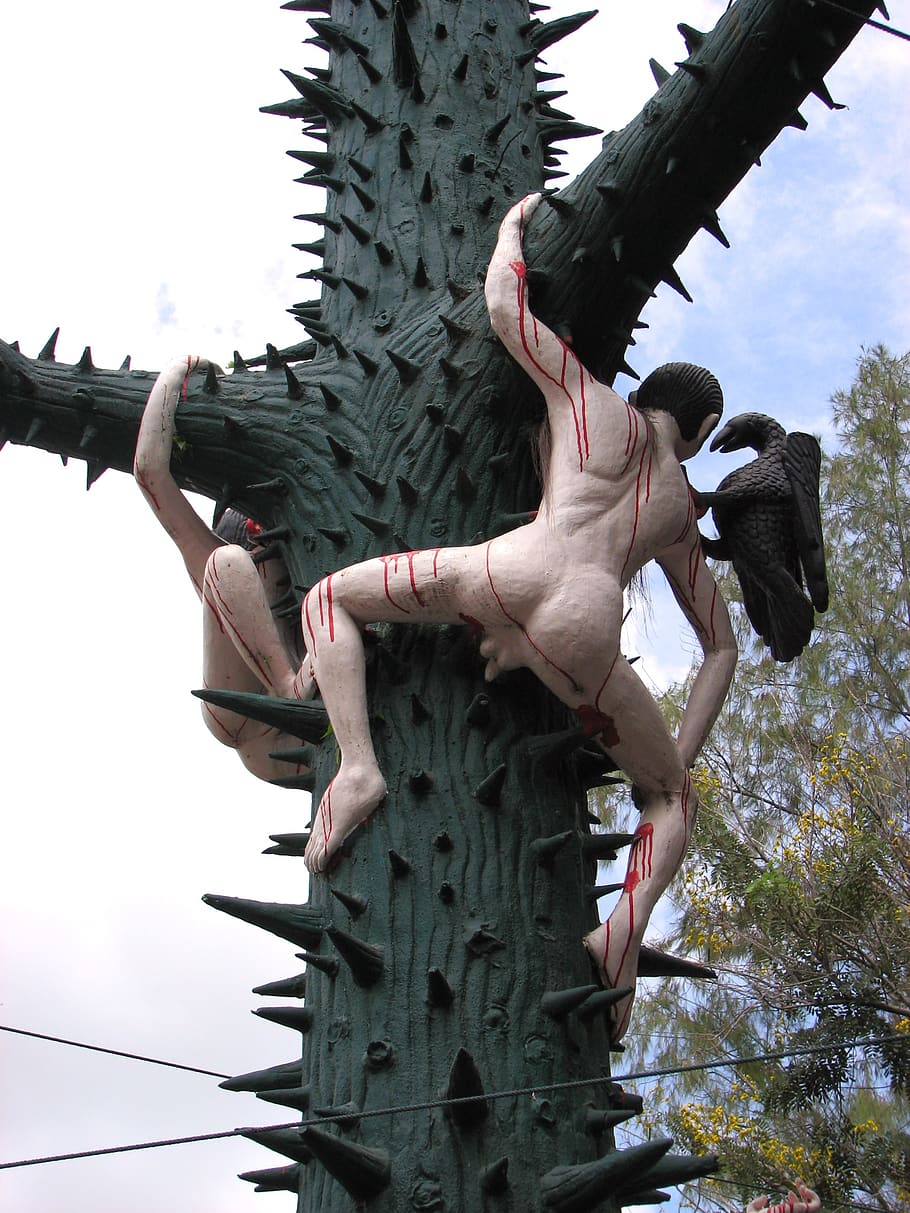
Hell Temples in Thailand
There are “hell temples” scattered throughout Thailand, where Buddhist temples depict Thailand’s historical vision of hell. Some of the most well-known include Wat Kai in Ayutthaya, Wat Phai Rong Wua in Suphanburi, Wat Mae Kaet Noi in Chiang Mai, Wat Ban Waeng in Udon Thani, Wat Muang in Ang Thong, Wat Pa Non Sawan in Roi Et, Wat Mai Plai Huai in Phichit, and Wat Pa Lak Roy in Nakhon Ratchasima, to name but a few.
Perhaps the two most famous “hell temples” in Thailand are Wat Suthat (วัดสุทัศน) and Wat Saen Suk (วัดแสนสุข). Wat Suthat is one of the most popular Thai temples in Bangkok. Along with beautiful architecture and Buddhist sculptures, it is famous for its depictions of hell, which include sinners burning up in a cauldron of boiling water, evil doers transformed into partial animals, and naked hell residents being forced to scale a trees of thorns while tormented by guards, dogs, and birds of prey.
Meanwhile Wat Saen Suk, located in the seaside province of Chonburi, is home to the famous Wang Saen Suk Hell Garden, whose depictions of hell include two giant Pretas (hungry ghosts), sinners being boiled alive, and all kinds of distorted and disfigured residents of hell.
In the Northeastern Thai province of Sakon Nakhon, there is Wat Khao Tham Phra, a mountain temple where once lived members of an ancient Khmer civilization. Here we see depictions of hell, including sinners pleading for mercy when the ledger of their life is being reviewed, as well as the following warning from the Buddha: “Old age is hidden in youth, sickness in good health, and death in life” (ความชรามี (ซ่อน) อยู่ในความหนุ่ม ความเจ็บไข้มี (ซ่อน) อยู่ในความไม่มีโรค ความตายมี (ซ่อน) อยู่ในชีวิต).
This wisdom from the Dharma, along with Thailand’s depictions of a gruesome Hell, are potent reminders to Thai Buddhists and visitors alike that we should always practice kindness, endeavor to do good deeds, and not misuse present good fortune.
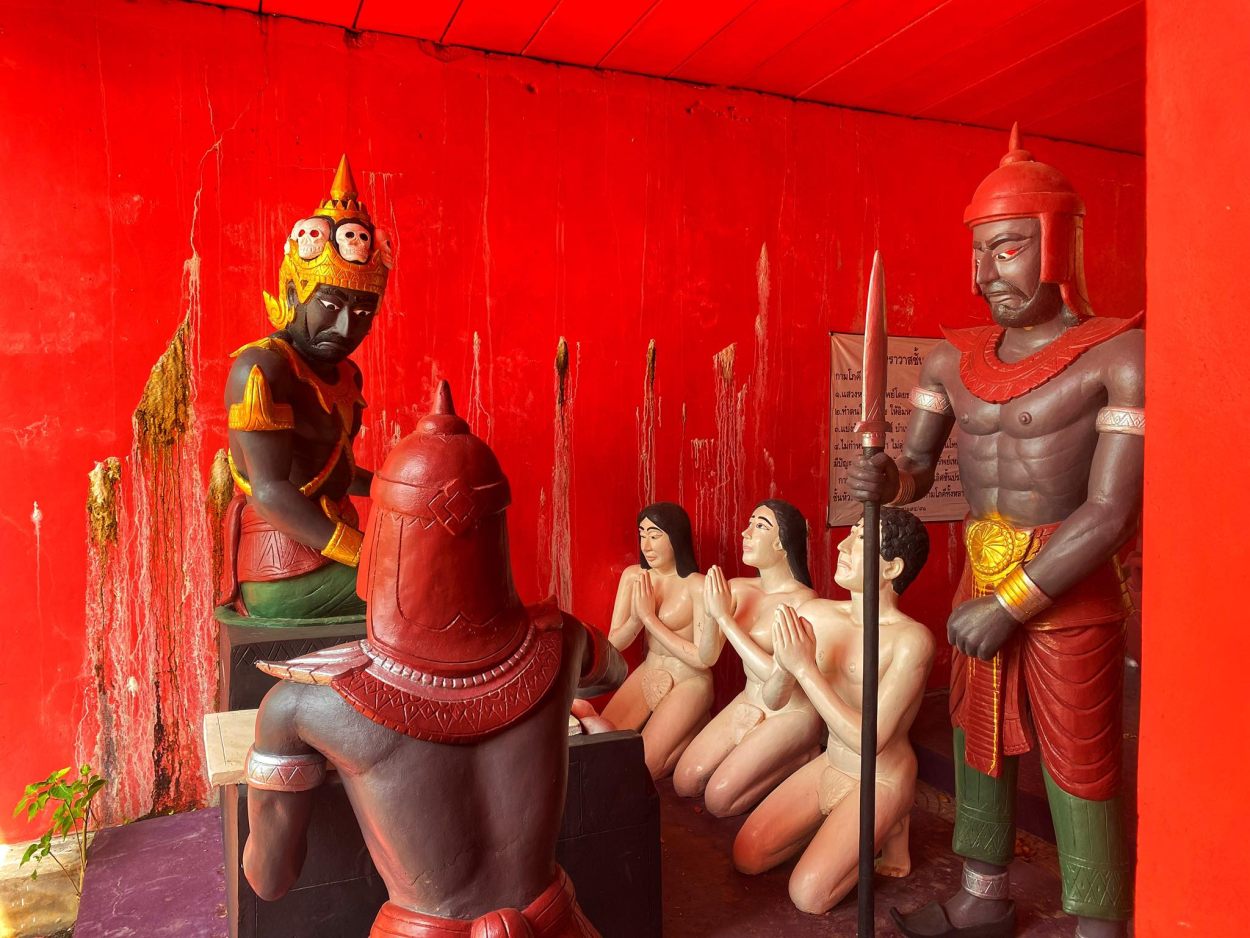
- Affirmations in Buddhism & Thailand - June 7, 2025
- Speak Thai Naturally Without the Gymnastics - April 20, 2025
- The Best Learn Thai Podcast and YouTube Channel - April 10, 2025

